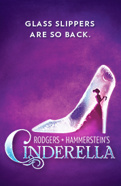Cinderella Orchestrator Danny Troob on the Secrets Behind Rodgers & Hammerstein's Irresistible Songs
About the author:
Danny Troob is a four-time Tony nominee for his work orchestrating the musicals Newsies, The Pajama Game, Shrek and now Cinderella. With 24 Broadway musicals under his belt, Troob knows a thing or two about how to make songs come alive on stage and affect an audience in just the right way. With Cinderella, Troob faced an unusual challenge: working with a Rodgers & Hammerstein score that had been expanded from a TV movie to a full-scale Broadway musical. The process, led by music supervisor and arranger David Chase, involved adding trunk songs from the R&H catalog and rearranging the existing score to fit the demands of a reconceived two-act show. In a fascinating essay for Broadway.com, Troob discusses the joy of his work process and explains why audiences instinctively love the music of Rodgers and Hammerstein.
![]()
In August of 2012, I was asked to participate in the first Broadway production of Rodgers’ and Hammerstein’s Cinderella. Job description: orchestrator. Cinderella was written for the small screen; Julie Andrews was the star, back in 1957, and the song score was rather limited, as TV or animated musicals tend to be.
At the workshop, I was impressed by the way this small score had been expanded to fit a large stage. Songs from other R&H properties had been added, and an almost unbroken tapestry of song, underscore and dance music held the show together. (Thank you, David Chase!) Now the show definitely was not small. Not in scope, and not in duration. The reading, with intermission, was almost three hours long, but excellent cuts were made in previews.
From the beginning, I knew Cinderella would be an enormous amount of work, but I was looking forward to getting up close and personal with the Rodgers and Hammerstein songs. When you write orchestrations, you absorb the language of the songwriters. And to write beautiful orchestrations, you have to lose yourself in their language, and recreate it yourself—a job that is more demanding spiritually than intellectually, and more of an emotional than a physical challenge.
The physical challenge is considerable, however. There is a period of four or five weeks (usually coinciding with Christmas or July 4) when every workday is 12 to 14 hours, and there are no days off. But the reward is “sharing the experience” of the writers at a very deep level—you get to live their dream, and for a while, you become responsible for making it come true to a new audience, in a new context.
It is a lot of responsibility, and sometimes, frankly, I would rather not think about that part. Fortunately, once work starts, you have so much to do that the big picture disappears, and instead of thinking, you are doing, one note at a time.
What Rodgers and Hammerstein could do is astonishing—a fact more or less universally acknowledged—but it becomes so much more vivid when you are dealing with their work on an intimate basis. Everyone is aware of how catchy their songs are, and how deeply they move an audience. What I discovered in the course of my work is how precise their craft is—how much complexity is involved in creating simplicity.
I don’t want to delve too deeply into specifics of musical theory, which can only be understood by other musicians. But here, in layman’s terms, are some of the miraculous achievements I found in every song in Cinderella—and, I think, can be found in all of the songs in the R&H catalog.
Musical range is compressed. The songs have a very large arc, but do it in the space of very few notes. So, the songs can be sung by a variety of singers, and by the average listener as well, without needing to dig for low notes or soar for money notes. The bridges of the songs—the contrasting sections—move into remote keys, which make them feel like new territory, but the still remain in the same register as the A sections. The result is great singer-friendliness.
The thematic material in an R&H song is extremely specific and is re-used in many ways within the same tune. The bridge of a song (say, “My Own Little Corner”) will be an echo—perhaps a reverse echo or an inverse echo—of the A section. This specificity, even stinginess if you will, gives each song great individuality. Catchiness. The song is what it is; it is not like another song, whether from the same show or from a different score. And as in all great dramatic writing, the songs run an enormous gamut of emotions. Happy, sad, jaunty, ironic, profound, casual, extroverted and very, very private.
Unlike many scores for families, Cinderella includes material that is very grown-up in tone. “Do I Love You Because You’re Beautiful” is a rapt meditation on the meaning of love that would not be out of place in an art song by Debussy, set to a text by Mallarmé. Contained within the range of an octave, the melody probes, wonders, soars. The impressionistic harmonies express the same ambiguities you find in the lyric. The accompaniment (written by Rodgers) has a baritone line that starts in unison with the voice, but continues to descend as the voice ascends—a second melody that adds weight to the vocal line, but with such subtlety that most people don’t even “hear” it as the song unfolds.
In terms of show-business savvy, R&H knew that they had satisfied the needs of the family audience and could allow themselves the luxury of a classic that makes no allowances and explores every nuance. Indeed, every song in this “simple” score is animated by hidden complexities of this kind. For all the production pressures and inexorable deadlines, it was an education and a great privilege for me to be able to hang out with this great music at such an intimate level.
